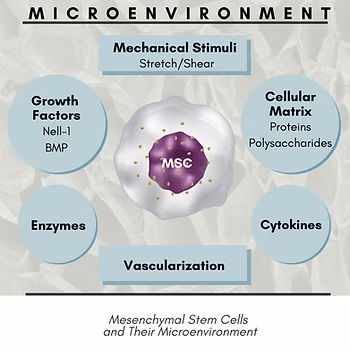
Like all stem cells, MSCs depend on their native microenvironment for chemical and mechanical signals to initiate proliferation, differentiation, and maintain homeostasis. Signals from a healthy microenvironment include mechanical stressors, cytokines, and growth factors. As a result, it may be likely that transporting MSCs into an unfavorable microenvironment could have a negative impact on bone repair. Ideally, the microenvironment the MSCs are transplanted into would closely mimic their native microenvironment.
Despite the importance of the microenvironment, in a survey of over 700 clinical studies involving MSCs, a majority of the trials used ceramic-based carriers or injected MSC directly into patients without a carrier, giving little insight into or control over the microenvironment in which the MSC are transplanted. Going forward, creating an optimal microenvironment for MSCs in bone regeneration requires further attention, as the potential benefits of creating an ideal microenvironment are numerous. To learn more, refer to “Stem and progenitor cell microenvironment for bone regeneration and repair” (Lee 2019).
#stemcells #microenvironment #osteogenesis #boneregeneration #bonegraftsubstitutes
© 2025 Molecular Matrix, Inc. All rights reserved.